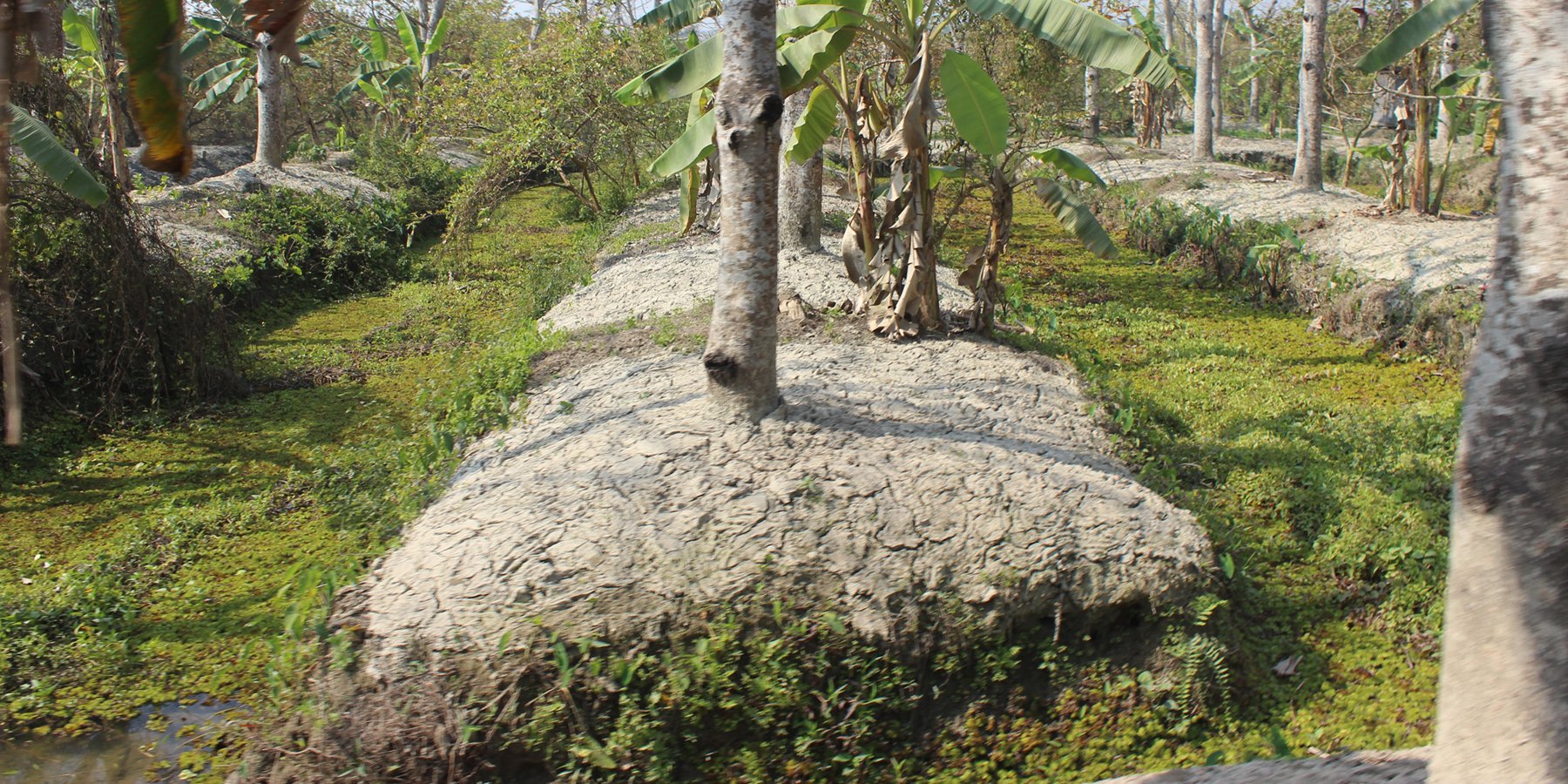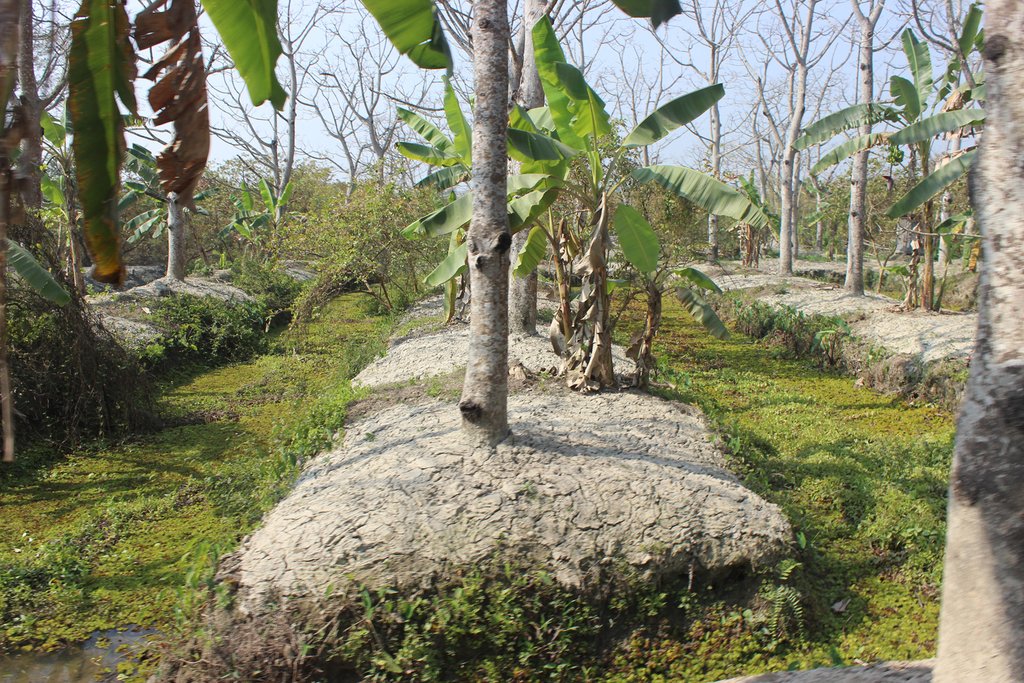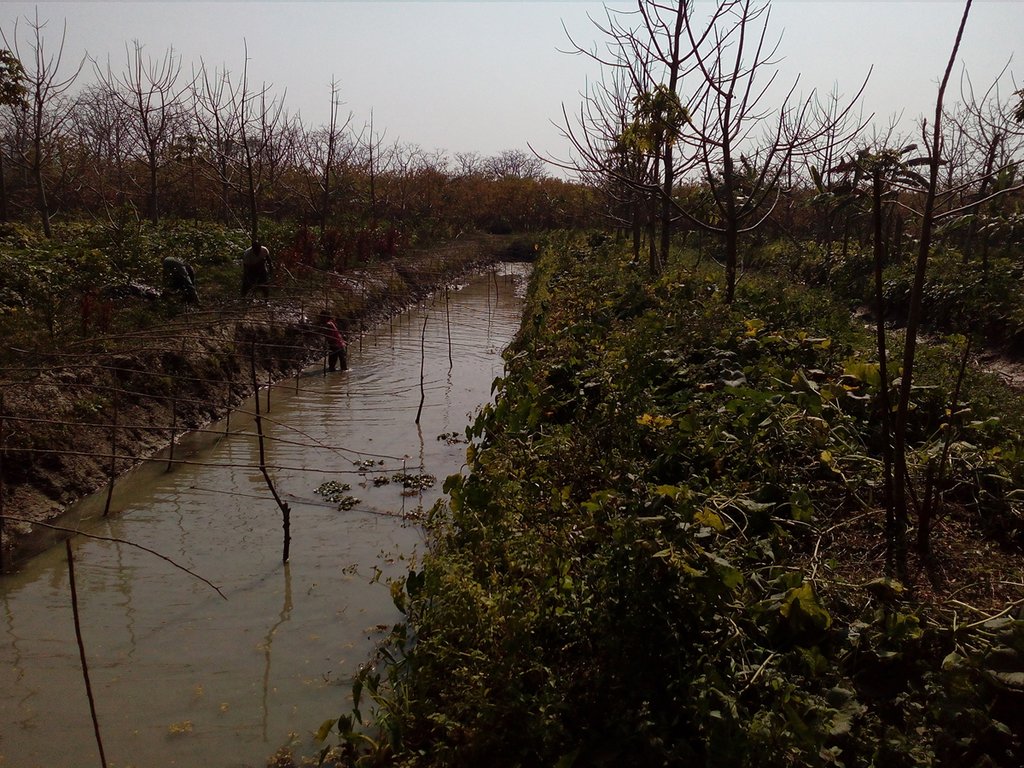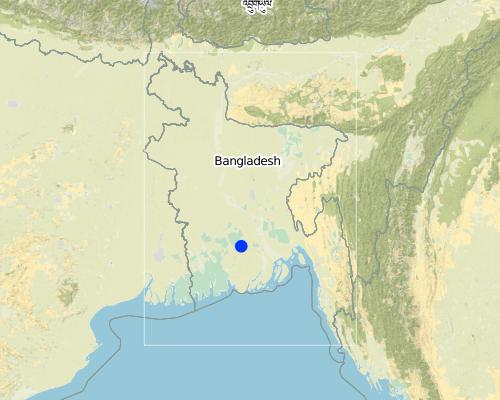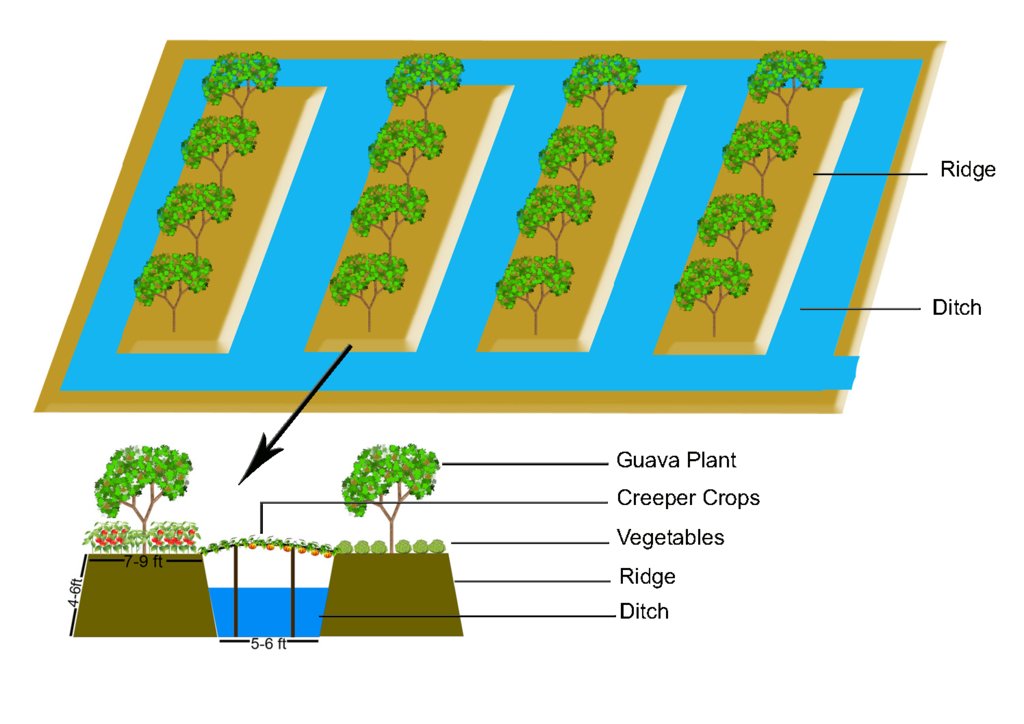Marshy land transformed into productive land [孟加拉国]
- 创建:
- 更新:
- 编制者: Rahatul Islam
- 编辑者: –
- 审查者: Ursula Gaemperli
technologies_1769 - 孟加拉国
查看章节
全部展开 全部收起1. 一般信息
1.2 参与该技术评估和文件编制的资源人员和机构的联系方式
1.3 关于使用通过WOCAT记录的数据的条件
(现场)数据是什么时候汇编的?:
24/01/2017
编制者和关键资源人员接受有关使用通过WOCAT记录数据的条件。:
是
1.4 所述技术的可持续性声明
这里所描述的技术在土地退化方面是否存在问题,导致无法被认为是一种可持续的土地管理技术?:
否
2. SLM技术的说明
2.1 技术简介
技术定义:
Marshy land is transformed into a ridge and ditch area, where the ridges are wide enough for the nursery of diverse plants and seedlings and where after 6-8 years the yearly management practices the land got strong enough for various agricultural practices (i.e. guava, hog plum, plums and timber wood plantation).
2.2 技术的详细说明
说明:
The technology of marshy land convert into ridge and ditch was taken by a community of southern of Bangladesh in order to make that area productive. Long year ago a continuous marshy land covered most of the area of southern Bangladesh like Pirjpur, Jhalokath. This area was flooded more than 9 month and remain perennial wet, that were totally unproductive. So, that technology not only increases agricultural production or economical benefits but also creates a green belt by developing agro-forest. The technology consists of ridge and ditch area. Ridges are elevated beds - land which is 4-6 feet high from surface and 7-9 feet wide. Length of each bed is variable according to size of the land. And ditches are canals - areas that are 5-6 feet wide and deeper than the normal surface area.
At initial stage elevated areas are not strong enough to start cultivating trees like guava, hug plum or other fruit plants. So they use it for nursery of diversified plants, fruit trees such as Banana and Papaya, vegetables, preparation of seedling sapling or as seedbed (rice). Management practices are running every year to develop the ridges and make them strong. Land users are putting soil/muck from the ditches on the ridges to make them higher and to give better protection from flooding water, to increase the fertility, to conserve moisture and reserve organic matter. Though eroded soil and other plant residues are accumulated in the ditches so ultimately they return over the ridge surface. Land become suitable after 4-5 year for planting various trees like guava hog plum, plums, lemons, Areca nuts and various timber producing tress like Teak (Tectona grandis), Mahogany (Swietenia mahagoni). Approximately 7 – 8 year after fruit trees are become appropriate and the physical and biological conditions of the sites have improved. Then land user start to cultivate various vegetables and other agricultural practices. Furthermore, sometime users set up a platform for creeper crops on the canal which works as support for Pumpkins and gourds. Trees and vegetables are irrigated from ditch/canal where water is reserve over the year, even in dry season if necessary. As a result of growing biomass, land degradation from the site has reduced and the fertility of the soil has increased. When fruit trees have reached its harvesting stage, the land users collect fruits for sale with expected income of about 1000USD. Vegetable also provide more than 500USD benefit from each site every year. Approximately 25 years after Mahogany, Teak, and other timber producing trees are getting mature and reach their harvesting stage. Land user cut the trees for selling with expected income of about 10000 USD from each site and size of approximately one hectare.
The technology is working well and is easily manageable by the land users. Nowadays not only farmers but also a large portion of population are interacting with that technology and their lifestyle have changed. Many people are also working to manufacture initial nursery products like seedling bag, earthen pot, creeping materials like bamboo, string, yarn, net, seedling and other material for preparing plant nursery, fruit garden, mixed agro-forest etc. Other people work to transport product from the area to the consumers and some people work to manufacture vehicles like boats, local vans etc. Also locale communities developed the largest floating market of Bangladesh.
The farmers are applying the technology without any extra financial support. According to the land users, they estimate about 200 – 300 family which have applied the technology. Approximately 350 person-day/ha were employed for construction and 50 person – day/ha sufficient for yearly maintenance work. 1600 USD was spending on the construction and most of the cost covered by owner. Farmers have faced some drawback such as undeveloped communication infrastructure and insufficiently developed market places. On the other hand, if they get support from government and related authority, this technology even become more beneficial for them.
2.3 技术照片
2.5 已应用该技术的、本评估所涵盖的国家/地区/地点
国家:
孟加拉国
区域/州/省:
Atghar Kuriana Union, Swarupkati, Pirojpur
有关地点的进一步说明:
Barisal
注释:
sites are increasing day by day and enter into deep swampy land
Map
×2.6 实施日期
如果不知道确切的年份,请说明大概的日期:
- 10-50年前
2.7 技术介绍
详细说明该技术是如何引入的:
- 通过土地使用者的创新
3. SLM技术的分类
3.1 该技术的主要目的
- 改良生产
- 创造有益的经济影响
- 创造有益的社会影响
3.2 应用该技术的当前土地利用类型

农田
- 一年一作
- 多年一作(非木材)
- 乔木与灌木的种植
主要农作物(经济作物及粮食作物):
Main crops are guava and hog plum. vegetables are harvested within five to six month. Bananas and papaya stay for several years. woody trees are harvest after they get mature.

混合(作物/放牧/树木),包括农林
- 农林业
3.3 有关土地利用的更多信息
该技术所应用土地的供水:
- 雨养
每年的生长季节数:
- 1
具体说明:
perennial
3.4 该技术所属的SLM组
- 农业林学
- 湿地保护/管理
- convert marshy land into productive ridge and ditch
3.5 技术传播
具体说明该技术的分布:
- 均匀地分布在一个区域
如果该技术均匀地分布在一个区域上,请注明覆盖的大致区域。:
- 10-100 平方千米
注释:
The technology expanding with time.
3.6 包含该技术的可持续土地管理措施

农艺措施
- A1:植被和土壤覆盖层

植物措施
- V1:乔木和灌木覆盖层

结构措施
- S2:堤、岸
3.7 该技术强调的主要土地退化类型

物理性土壤退化
- Pw:水浸

水质恶化
- Hs:地表水良变化
注释:
Land was lower and flooded more than 9 month and remain perennial wet. So the technology helps to overcome waterlogged condition and remain surface water over the year even in dry season at ditch area.
3.8 防止、减少或恢复土地退化
具体数量名该技术与土地退化有关的目标:
- 修复/恢复严重退化的土地
4. 技术规范、实施活动、投入和成本
4.1 该技术的技术图纸
4.2 技术规范/技术图纸说明
Method of marshy land transform into productive land bases on ridges and ditches. ridges are 7-9 feet wide and 4-6 feet high. Height is variable because yearly management practices increase the height of the ridges. Ditches are connected with each other from the edge/end of the each ridge. This types of connection support water movement and the moving of the boats for crop management and crop harvesting.
4.3 有关投入和成本计算的一般信息
具体说明成本和投入是如何计算的:
- 每个技术区域
注明尺寸和面积单位:
1 hectare
具体说明成本计算所用货币:
- 美元
注明雇用劳工的每日平均工资成本:
5 USD
4.4 技术建立活动
| 活动 | 措施类型 | 时间 | |
|---|---|---|---|
| 1. | Develop ridge and ditch | 结构性的 | 7-15 days |
| 2. | vegetative cover with vegetables, seedling, sapling | 植物性的 | 2-3 months |
| 3. | fruit trees, timber producing trees | 植物性的 | 3-25 years |
注释:
Mainly the structural measure are important. But other measures are also important to make the technology stable. At initial stage without vegetative measure, soil will not become stable enough to take further steps of plantation.
4.5 技术建立所需要的费用和投入
如果可能,按下表分列技术建立费用,并列明各项投入和每项投入的费用。如果您无法分解成本,给出建立该技术的总成本估算。:
3.0
| 对投入进行具体说明 | 单位 | 数量 | 单位成本 | 每项投入的总成本 | 土地使用者承担的成本% | |
|---|---|---|---|---|---|---|
| 劳动力 | skilled labor | person-days | 300.0 | 5.0 | 1500.0 | 100.0 |
| 植物材料 | seedling (fruit trees) | piece | 500.0 | 0.1 | 50.0 | 100.0 |
| 植物材料 | seedling (timber producing trees) | piece | 300.0 | 0.1 | 30.0 | 100.0 |
| 其它 | seedling bag | 1000.0 | 0.01 | 10.0 | 100.0 | |
| 其它 | earthen pot | 1000.0 | 0.01 | 10.0 | 100.0 | |
| 技术建立所需总成本 | 1600.0 | |||||
4.6 维护/经常性活动
| 活动 | 措施类型 | 时间/频率 | |
|---|---|---|---|
| 1. | management practice to make ridges and ditches uniform and productive | 结构性的 | 3-7days |
| 2. | seasonal vegetable | 植物性的 | 2-3 month |
4.7 维护/经常性活动所需要的费用和投入(每年)
| 对投入进行具体说明 | 单位 | 数量 | 单位成本 | 每项投入的总成本 | 土地使用者承担的成本% | |
|---|---|---|---|---|---|---|
| 劳动力 | skilled labor | person-days | 50.0 | 5.0 | 250.0 | 100.0 |
| 植物材料 | seedling vegetable ( e.g gourd) | pieces | 250.0 | 0.05 | 12.5 | 100.0 |
| 施工材料 | bamboo | pieces | 50.0 | 1.0 | 50.0 | 100.0 |
| 施工材料 | string, ropes | piece | 1.0 | 5.0 | 5.0 | 100.0 |
| 技术维护所需总成本 | 317.5 | |||||
4.8 影响成本的最重要因素
描述影响成本的最决定性因素:
Basket, spade and other equipment which are needs to develop the site is not carried by land user, these are collecting by laborers. transportation cost also carried by local traders. farmers are represent their product in local market (floating guava market) and then local traders are buy it and transport it to city or capital
5. 自然和人文环境
5.1 气候
年降雨量
- < 250毫米
- 251-500毫米
- 501-750毫米
- 751-1,000毫米
- 1,001-1,500毫米
- 1,501-2,000毫米
- 2,001-3,000毫米
- 3,001-4,000毫米
- > 4,000毫米
有关降雨的规范/注释:
Length of rainy season 5 month that causes water level becoming close to the bed.
农业气候带
- 半湿润
5.2 地形
平均坡度:
- 水平(0-2%)
- 缓降(3-5%)
- 平缓(6-10%)
- 滚坡(11-15%)
- 崎岖(16-30%)
- 陡峭(31-60%)
- 非常陡峭(>60%)
地形:
- 高原/平原
- 山脊
- 山坡
- 山地斜坡
- 麓坡
- 谷底
垂直分布带:
- 0-100 m a.s.l.
- 101-500 m a.s.l.
- 501-1,000 m a.s.l.
- 1,001-1,500 m a.s.l.
- 1,501-2,000 m a.s.l.
- 2,001-2,500 m a.s.l.
- 2,501-3,000 m a.s.l.
- 3,001-4,000 m a.s.l.
- > 4,000 m a.s.l.
说明该技术是否专门应用于:
- 不相关
5.3 土壤
平均土层深度:
- 非常浅(0-20厘米)
- 浅(21-50厘米)
- 中等深度(51-80厘米)
- 深(81-120厘米)
- 非常深(> 120厘米)
土壤质地(表土):
- 中粒(壤土、粉土)
土壤质地(地表以下> 20厘米):
- 中粒(壤土、粉土)
表土有机质:
- 高(>3%)
5.4 水资源可用性和质量
地下水位表:
< 5米
地表水的可用性:
好
水质(未处理):
仅供农业使用(灌溉)
水的盐度有问题吗?:
否
该区域正在发生洪水吗?:
是
规律性:
偶然
关于水质和水量的注释和进一步规范:
flooding normally occur in rainy season but it is not destructive for the technology
5.5 生物多样性
物种多样性:
- 中等
栖息地多样性:
- 中等
关于生物多样性的注释和进一步规范:
This green belt workes as shelter for birds.
5.6 应用该技术的土地使用者的特征
定栖或游牧:
- 定栖的
生产系统的市场定位:
- 混合(生计/商业
非农收入:
- 收入的10-50%
相对财富水平:
- 丰富
个人或集体:
- 个人/家庭
机械化水平:
- 手工作业
性别:
- 女人
- 男人
土地使用者的年龄:
- 中年人
5.7 应用该技术的土地使用者拥有或租用的平均土地面积
- < 0.5 公顷
- 0.5-1 公顷
- 1-2 公顷
- 2-5公顷
- 5-15公顷
- 15-50公顷
- 50-100公顷
- 100-500公顷
- 500-1,000公顷
- 1,000-10,000公顷
- > 10,000公顷
这被认为是小规模、中规模还是大规模的(参照当地实际情况)?:
- 中等规模的
注释:
Size depends on user capability. Sometime users like to make smaller sites which are easy to maintain. Larger sites reduce waste of land and give extra space to cultivation.
5.8 土地所有权、土地使用权和水使用权
土地所有权:
- 个人,有命名
土地使用权:
- 个人
用水权:
- 自由进入(无组织)
5.9 进入服务和基础设施的通道
健康:
- 贫瘠
- 适度的
- 好
教育:
- 贫瘠
- 适度的
- 好
技术援助:
- 贫瘠
- 适度的
- 好
就业(例如非农):
- 贫瘠
- 适度的
- 好
市场:
- 贫瘠
- 适度的
- 好
能源:
- 贫瘠
- 适度的
- 好
道路和交通:
- 贫瘠
- 适度的
- 好
饮用水和卫生设施:
- 贫瘠
- 适度的
- 好
金融服务:
- 贫瘠
- 适度的
- 好
6. 影响和结论性说明
6.1 该技术的现场影响
社会经济效应
生产
作物生产
注释/具体说明:
bare land become productive
作物质量
注释/具体说明:
organic materials are mainly used
饲料生产
注释/具体说明:
vegetable and fruit resides can use as animal food
饲料质量
木材生产
注释/具体说明:
timber trees not only fill local demand but also supply in many area of Bangladesh
森林/林地质量
生产故障风险
注释/具体说明:
Crop failure by flooding is protected
产品多样性
注释/具体说明:
Here produce timber, fruit, vegetable, seedling sapling etc
生产区域
注释/具体说明:
production area remarkably increase
土地管理
注释/具体说明:
Very easy and local farmers manage it easily.
水资源可用性和质量
灌溉用水的可用性
注释/具体说明:
Water is available even in dry season
灌溉用水的质量
灌溉用水需求
注释/具体说明:
ditch contain enough water in available condition for plant
收入和成本
农业投入费用
农业收入
收入来源的多样性
注释/具体说明:
Peoples not only depend on agriculture.
经济差异
注释/具体说明:
It reduces the economic disparities as it opens new working places.
工作量
社会文化影响
食品安全/自给自足
注释/具体说明:
Net yearly production of food increases.
健康状况
注释/具体说明:
People get proper nutrient from fruits and vegetable, which are totally chemical free
土地使用权/用水权
文化机会
社会经济弱势群体的情况
注释/具体说明:
not only men but also women are work on site. normally land users family members are always help them every way
生态影响
水循环/径流
水量
注释/具体说明:
Total amount of water is reduced.
水质
注释/具体说明:
Good quality water found in all seasons.
多余水的排放
注释/具体说明:
Drainage condition of cultivated ridge area is very good
蒸发
注释/具体说明:
Vegetative cover reduces the total evaporation .
土壤
土壤水分
注释/具体说明:
Yearly management practice helps to increase the soil moisture.
土壤覆盖层
注释/具体说明:
Annual and perennial crops cover the area.
土壤流失
养分循环/补给
注释/具体说明:
Plant residue.
土壤有机物/地下C
注释/具体说明:
Release reserved carbon from muck.
生物多样性:植被、动物
植被覆盖
注释/具体说明:
A bare land convert into vegetative cover
生物量/地上C
植物多样性
注释/具体说明:
Variety among plants and crops is seem.
动物多样性
注释/具体说明:
The trees serve as nesting habitat
有益物种
减少气候和灾害风险
洪水影响
注释/具体说明:
ridges are free from flood
干旱影响
注释/具体说明:
water reserved in ditch in dry season
碳和温室气体的排放
注释/具体说明:
large vegetation consume huge amount of carbon dioxide and greenhouse gases
风速
微气候
6.2 该技术的场外影响已经显现
水资源可用性
缓冲/过滤能力
风力搬运沉积物
对邻近农田的破坏
对公共/私人基础设施的破坏
温室气体的影响
6.4 成本效益分析
技术收益与技术建立成本相比如何(从土地使用者的角度看)?
短期回报:
轻度消极
长期回报:
非常积极
技术收益与技术维护成本/经常性成本相比如何(从土地使用者的角度看)?
短期回报:
稍微积极
长期回报:
非常积极
注释:
To develop such kinds of structure requires a huge amount of investment which is not covered in a short time. But in the future it becomes highly beneficial. Yearly maintenance practices not only increase soil fertility, moisture and nutrient availability but land become higher from flooding water as well.
6.5 技术采用
- 1-10%
在所有采用这项技术的人当中,有多少人是自发地采用该技术,即未获得任何物质奖励/付款?:
- 50-90%
6.6 适应
最近是否对该技术进行了修改以适应不断变化的条件?:
否
6.7 该技术的优点/长处/机会
| 土地使用者眼中的长处/优势/机会 |
|---|
| The Technology increase the amount of productive land. |
| Peoples economic condition have changed to the better. This technology creates working place for many people. |
| The Technology increase availability of fresh products. e.g vegetable, fruits. |
| The development of largest floating market of Bangladesh is seen as very positive. |
| 编制者或其他关键资源人员认为的长处/优势/机会 |
|---|
| The Technology increase the greenhouse gas consumption. |
| Seedling and sapling are distributed in whole country and increase the vegetation cover. |
| It fulfills the demand of timber and it reduces the deforestation of natural forests. |
6.8 技术的弱点/缺点/风险及其克服方法
| 土地使用者认为的弱点/缺点/风险 | 如何克服它们? |
|---|---|
| The communication and transport infrastructure is not very well developped. | Reconstruction of the road. |
| Floating market are temporary and disapear after morning. | Make stable market places. |
| Farmer have no precise knowledge about crop, seeds and hybrid varieties. | Government and non-government organizations services is required. |
| 编制者或其他关键资源人员认为的弱点/缺点/风险 | 如何克服它们? |
|---|---|
| Water ecosystem is hampered | More research should be taken |
| Huge amount of reserved carbon get released. | Planting enough tree to consume that |
7. 参考和链接
7.1 信息的方法/来源
- 实地考察、实地调查
- 与土地使用者的访谈
链接和模块
全部展开 全部收起链接
无链接
模块
无模块


